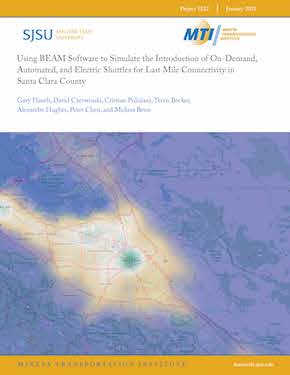- 408-924-7560
- mineta-institute@sjsu.edu
- Donate
Using BEAM Software to Simulate the Introduction of On-Demand, Automated, and Electric Shuttles for Last Mile Connectivity in Santa Clara County
Despite growing interest in low-speed automated shuttles, pilot deployments have only just begun in a few places in the U.S., and there is a lack of studies that estimate the impacts of a widespread deployment of automated shuttles designed to supplement existing transit networks. This project estimated the potential impacts of automated shuttles based on a deployment scenario generated for a sample geographic area: Santa Clara County, California. The project identified sample deployment markets within Santa Clara County using a GIS screening exercise; tested the mode share changes of an automated shuttle deployment scenario using BEAM, an open-source beta software developed at the Lawrence Berkeley National Laboratory to run traffic simulations with MATSim; elaborated the model outputs within the R environment; and then estimated the related impacts. The main findings have been that the BEAM software, despite still being in its beta version, was able to model a scenario with the automated shuttle service: this report illustrates the potential of the software and the lessons learned. Regarding transportation aspects, the model estimated automated shuttle use throughout the county, with a higher rate of use in the downtown San José area. The shuttles would be preferred mainly by people who had been using gasoline-powered ride hail vehicles for A-to-B trips or going to the bus stop, as well as walking trips and a few car trips directed to public transport stops. As a result, the shuttles contributed to a small decrease in emissions of air pollutants, provided a competitive solution for short trips, and increased the overall use of the public transport system. The shuttles also presented a solution for short night trips—mainly between midnight and 2 am—when there are not many options for moving between points A and B. The conclusion is that the automated shuttle service is a good solution in certain contexts and can increase public transit ridership overall.
GARY HSUEH
Gary is the Director of Mobility Programs at CHS Consulting Group and a Mineta Transportation Institute Consulting Associate. He develops and implements transportation technology demonstration projects and establishes industry–civic–academic partnerships to benefit society. Gary recently supported the Santa Clara VTA Accessible Automated Vehicle demonstration project, and also concluded the role of Principal Investigator for the FTA-funded Palo Alto Mobility on Demand Demonstration Project. Previously, Gary worked for nearly 13 years as a transportation planner with Arup, and he is a certified planner (AICP). Gary holds a BA in Geography from UC Berkeley and an MS in Transportation Management through the Mineta Transportation Institute at San José State University.
DAVID CZERWINSKI
David is an Associate Professor in the Department of Marketing and Business Analytics at San José State University and a Mineta Transportation Institute Research Associate. His research involves the application of techniques from operations research and statistics to problems in the private and public sectors. He previously worked in the Planning Department of the Chicago Transit Authority and as a Senior Associate at Transportation Management & Design. He holds a BS in Mathematical and Computational Science from Stanford University and a PhD in Operations Research from the Massachusetts Institute of Technology.
CRISTIAN POLIZIANI
Cristian is a PhD student at the Department DICAM of the University of Bologna, Italy in the field of Transport Engineering. His research activity focuses on the development of large-scale traffic micro-simulation models and on performing deep analysis of big data related to GPS traces of cyclists, pedestrians, and public transport users in order to estimate the impacts and the performance of sustainable means of transport. Cristian currently is a Visiting Scholar at San José State University in collaboration with the nonprofit organization Prospect Silicon Valley.
TERRIS BECKER
Terris Becker is a statistician with an MS in Statistics from San José State University and is currently working for a finance company in Vancouver, WA as a data analyst. His areas of expertise are statistical modeling, experimental design and analysis, and stochastic processes.
ALEXANDRE HUGHES
Alexandre is a practicing planner working on citywide planning and public policy. He graduated from San José State University with his Master’s Degree in Urban and Regional Planning in 2019. His Master’s project focused on the intersection of university policy and the use of electric scooter-share devices using GIS analytics.
PETER CHEN
Peter Chen, PhD, is a Senior Transportation Planner at Santa Clara Valley Transportation Authority. He obtained his BS and MS from National Taiwan University, his PhD from University of Maryland, College Park, and an MBA from Santa Clara University. Peter works across several diverse fields including public transportation planning and operations, traffic simulation, and travel demand modeling, especially the recent development of activity-based models and their application to public transportation. He is a member of the Bus Transit Systems Committee and the Public Transportation Planning and Development Committee of the Transportation Research Board as well as being a handling editor of Transportation Research Record Board.
MELISSA BENN
Melissa is a Program Associate at Prospect Silicon Valley. She earned her BA in Environmental Studies from the University of California, Santa Cruz in 2016, specializing in sustainable architecture and ecological conservation. She joined Prospect Silicon Valley in January 2018 as a fellow through Climate Corps Bay Area and has since transitioned to engage in many transportation initiatives including the Palo Alto Mobility on Demand Demonstration Project, the Santa Clara VTA Vehicle-to-Grid Integration Project, Transit Technology and Connected Vehicle Working Groups, and the VTA Accessible Automated Vehicle demonstration project.
-
Contact Us
San José State University One Washington Square, San Jose, CA 95192 Phone: 408-924-7560 Email: mineta-institute@sjsu.edu






